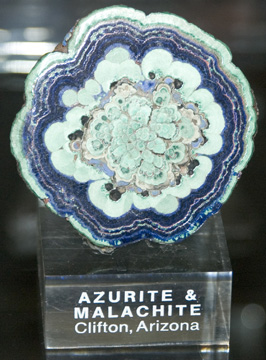
Crystal system: Monoclinic
Chemical Formula/composition: Cu2(CO3)(OH)2
Crystal habit: often
forms banded or bubbly masses (botryoidal texture)
Hardness: 3½
- 4
Specific gravity: 3.5-4
Luster: earthy,
vitreous, silky
Toughness: brittle
Cleavage: Not
apparent obvious in massive deposits
Color: Distinctive green, but often
with banding. May be mixed with other minerals in the bands.
Localities: Siberia,
Namibia, Congo, Australia, North Carolina, Arizona.
Common simulants: often
imitated by painting
Synthetics: none
Malachite is an opaque mineral; as such it can only be classified as a semiprecious stone. Its low hardness, porous nature, and solubility in acid mean it may be subject to damage during normal wear in jewelry. Yet with all its drawbacks, it is a popular shade of green and may have characteristics such as color banding that may it very attractive in jewelry and as an ornamental stone. The example shown below has both banding and a botryoidal texture and is interlayered with azurite (a blue copper mineral closely related to malachite).

Malachite's softness lends itself to carving. Attractive carvings and ornaments are made that take advantage of the banded texture to make the pieces come to life with interesting shapes and designs. Because it is opaque and scratches do not greatly diminish its beautiful color, it can be used in jewelry. It is best for pendants, earrings, and beads, but it is also set in inexpensive rings and bracelets.
Malachite's presence in a deposit indicates an ore of copper is close
at hand. Malachite forms in the oxidized zone of copper deposits
and may fill cracks and also forms cave-like deposits such as stalactites
and stalagmites.